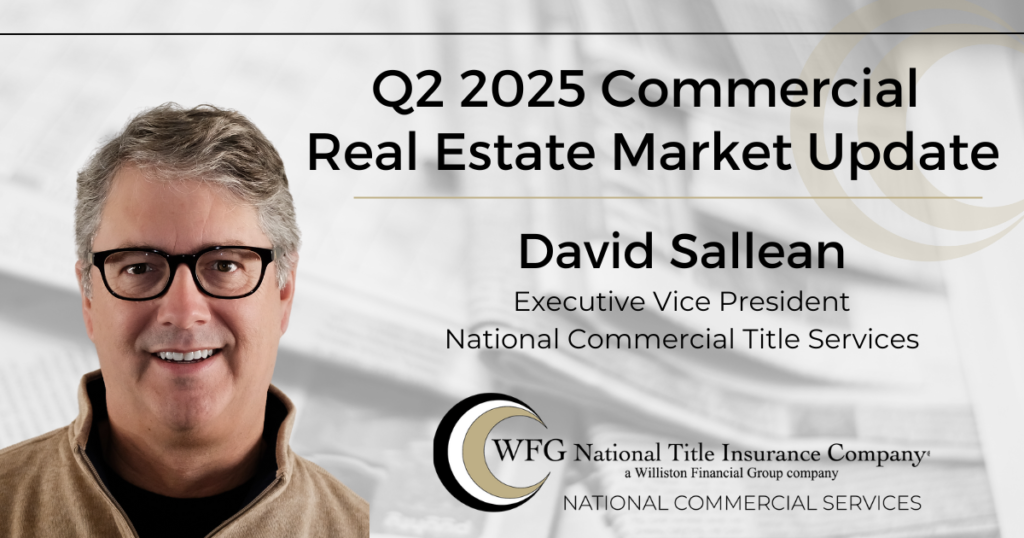
The end of Q2 saw the passage of significant legislation in Washington known as the One Big Beautiful Bill (OBBB). The bill introduced numerous changes to the U.S. Tax code, many of which have direct implications for commercial real estate. This followed closely on the heels of the tariff announcements and subsequent deal-making.
How does the OBBB impact the future of commercial real estate?
For one, it makes the Opportunity Zones provision a permanent part of the tax code. This provision from the 2017 Tax Cuts and Jobs Act is an economic development initiative designed to promote investments in distressed communities. Investors receive tax benefits for investing in businesses or real estate located in these state-designated Opportunity Zones.
The OBBB also reinstates the 100% bonus depreciation, which allows businesses to immediately deduct the amount paid for large purchases in the year acquired rather than spreading it over the life of the asset, which is currently valued at forty years for real estate. This change is intended to stimulate investment in business growth and has been used as a lever by both democrats and republicans in various administrations.
Other changes include corporate tax rate cuts and permanently enshrining the 20% deduction for pass-through entities, which can be beneficial for real estate transactions. Alternatively, the OBBB will phase out tax credits for solar and wind renewable projects by eliminating incentives for projects that don’t break ground within a year or that aren’t completed by 2027. Ironically, this change may actually spur activity in the near term. Regardless, these projects will continue to be pursued if tech giants like Microsoft and Meta continue to demand more energy to supply the huge demands created by artificial intelligence.
Another headline-grabbing issue is the Federal Reserve’s current wait-and-see approach to interest rate reductions. The aforementioned tariffs have given Fed Chairman Powell and the rest of the Federal Open Market Committee enough pause to leave the policy interest rate unchanged as of the June 18, 2025, meeting. With consistent GDP growth, a solid labor market, and inflation down from the highs of 2022, but still above the Fed’s 2% target, the committee has opted to maintain the current federal funds rate. Cap rates for CRE have remained stable within each market segment.
How do these policies impact the state of CRE mid-2025?
Since Q4 2025, there has been increased activity, with lending standards loosening, price discovery recovering, and asset write-downs decreasing. These new policy changes have created uncertainty as investors wait to see how things work out. CRE heavily favors stability and predictability. As a result, huge dollars are waiting on the sidelines.
For instance, Blackstone Real Estate Partners X has over $30B in capital, with $18.5B of dry powder. Similarly, TPG and Brookfield also have billions of dollars of dry powder on standby. With such significant funds available for commercial real estate investment, there is cautious optimism that we could see an increase in commercial transaction activity throughout the remainder of 2025 and into 2026.
Segment News:
- Office – The US office market has seen green shoots recently, with leasing activity increasing in certain major markets, although volumes remain below the pre-pandemic levels. The return-to-office trend and office-to-residential conversions have bolstered this activity.
- Industrial – The industrial market continues to hold footing, but it is location and sub-sector specific. Vacancies have increased in some markets, and the pipeline of new construction is declining.
- Retail – There are signs of life in the retail sector due to continued low unemployment and general consumer optimism. This segment has been under stress for quite a while, so slight increases in certain markets are welcome.
- Multi-family – This market segment is stable in demand, but also market-specific. Dallas remains at or near the top of the multi-family growth market.
- Energy – Data center demand remains strong, as does battery storage. Power generation should continue to see growth, but may or may not be impacted by provisions of the OBBB.
The verdict for CRE? Hold on and remain flexible, as it should be an interesting second half of 2025.